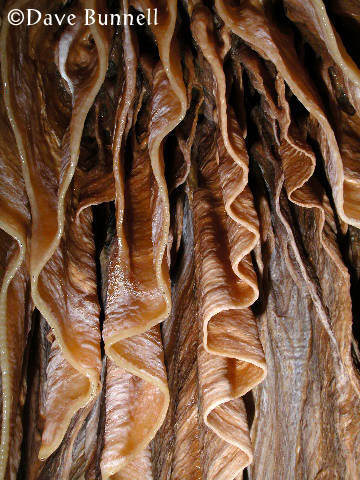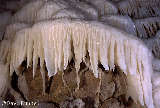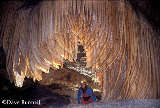
|
Among the most beautiful of cave formations, draperies are deposited from calcite-rich solutions flowing along an overhung surface. Surface tension
allows these solutions to cling to a wall or sloping ceiling as they stream slowly downward. Loss of carbon
dioxide to the cave atmosphere then causes the solutions to become supersaturated with respect to calcite,
which is deposited in a thin trails. Initial calcite trails, hanging slightly lower than the
surrounding surface, become preferential routes for continued flow, and so develop into slender, delicate sheets.
Ripples and folds in cave draperies, which reflect the erratic path of pioneer flow routes, are reminiscent of 'drapes' of supple cloth, and the likeness provided an obvious name for these formations. Another fitting name, however, is sometimes given to the multi-colored, translucent draperies seen in the photos below. The dark and light bands, generally a product of the waxing and waning supply of organic acids to the seep solution, remind many cavers of "bacon". While bacon is often used interchangeably with draperies among lay people, draperies often have no colored banding at all, as seen in the left-most of the additional images available at the bottom. |
![]()

 |
 |

 |
 |
 |
Choose a thumbnail to see more images of draperies.
![]()
| Back to: | |
 |
Created: June 19, 1995 Last Updated: Nov. 16, 2010 Authors: Djuna Bewley & Dave Bunnell |